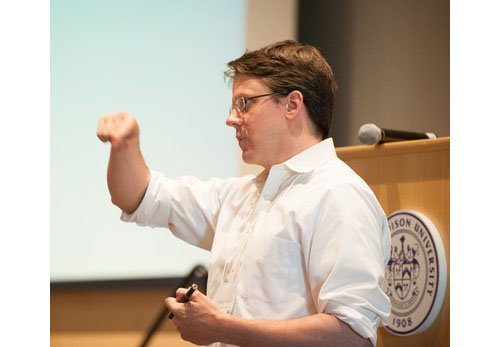How a Soft X-ray FEL Could Reveal the Most Fundamental Processes in Exotic Materials
Location
Harrisonburg, VA
Start Date
16-5-2012 3:20 PM
End Date
16-5-2012 4:00 PM
Description
In the field of condensed matter physics we usually say we “understand” a system if we have a low energy theory that accomplishes two things: (1) It adequately describes the low energy Fermion degrees of freedom in the system, including the Fermi surface, and (2) it adequately describes the charged collective modes. One of the biggest problems in the field is that while we have outstanding probes of the Fermions (e.g., angle-resolved photoemission spectroscopy, scanning tunneling spectroscopy, etc.), we lack comparable probes of the collective modes. This makes it extremely difficult to formulate and test new theories, which has been a roadblock for the whole field.
In this talk, I will argue that a soft x-ray free electron laser, such as that proposed at Jefferson Lab, may be the first effective probe of the collective excitations in interacting electron systems. In addition to having superior, time-averaged performance, the high peak power and longitudinal coherence of an FEL allows a number of novel new approaches to studying excitations, for example by analyzing the decoherence induced in scattered pulses, measuring nonlinear response functions that are related to higher order correlation functions, etc. This suggests that a soft x-ray FEL facility could drive a revolution in condensed matter physics, leading to a new paradigm for understanding complex materials.
Presenter Bio
Peter Abbamonte Associate Professor, Physics University of Illinois at Urbana-Champaign
Professor Peter Abbamonte received his Ph.D. from the University of Illinois at Urbana- Champaign in 1999, having done his research in the then thriving Materials Physics Department at Bell Laboratories. He then went to the University of Groningen in the Netherlands on an IRFAP fellowship from the National Science Foundation. In 2001, he returned to the U.S. as a postdoctorate in biophysics at Cornell University where he studied photosynthesis in Rhodobacter sphaeroides, and he joined the scientific staff at Brookhaven National Laboratory in 2003. He was recruited to the Department of Physics at Illinois in August of 2005.
Professor Abbamonte is one of the originators of the technique of resonant soft x-ray scattering, which he has used to discover a Wigner crystal in doped spin ladders, and to show that stripes in copperoxide superconductors are charged. This technique is now in use at every major synchrotron facility in the world. He is also known for his solution to the phase problem for inelastic x-ray scattering, permitting real-time imaging of electron motion in condensed matter with attosecond time resolution. He has recently used this approach to image the formation of excitons in insulators, and to measure the effective fine structure constant of graphene.
How a Soft X-ray FEL Could Reveal the Most Fundamental Processes in Exotic Materials
Harrisonburg, VA
In the field of condensed matter physics we usually say we “understand” a system if we have a low energy theory that accomplishes two things: (1) It adequately describes the low energy Fermion degrees of freedom in the system, including the Fermi surface, and (2) it adequately describes the charged collective modes. One of the biggest problems in the field is that while we have outstanding probes of the Fermions (e.g., angle-resolved photoemission spectroscopy, scanning tunneling spectroscopy, etc.), we lack comparable probes of the collective modes. This makes it extremely difficult to formulate and test new theories, which has been a roadblock for the whole field.
In this talk, I will argue that a soft x-ray free electron laser, such as that proposed at Jefferson Lab, may be the first effective probe of the collective excitations in interacting electron systems. In addition to having superior, time-averaged performance, the high peak power and longitudinal coherence of an FEL allows a number of novel new approaches to studying excitations, for example by analyzing the decoherence induced in scattered pulses, measuring nonlinear response functions that are related to higher order correlation functions, etc. This suggests that a soft x-ray FEL facility could drive a revolution in condensed matter physics, leading to a new paradigm for understanding complex materials.



